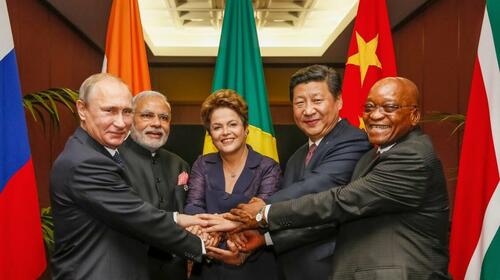- Moscow signed 10 new cooperation agreements with Iran for the oil sector alone on 18 May.
- China waited for the dust to settle before it too signed new cooperation agreements with Iran on 23 May.
- China has significantly expanded its influence in the Middle East in order to secure sufficient hydrocarbon supplies to fuel its economic growth.
Simon Watkins, OilPrice.com
The last week or so has seen a flurry of major cooperation agreements – including in energy, security, and logistics – between various permutations of Iran, Iraq, Russia, and China. Like a very dark version of the old U.S. soap opera parody ‘Soap’ this real-life version is equally convoluted, albeit a lot less funny. Its key elements constitute a significant part of the new global oil market order, which is analysed in depth in my new book on the subject, but the three most recent principal cooperation agreements will have immediate consequences for oil and gas flows around the world and their pricing.
The best place to start here is at the end point of what China wants in its grand scheme of things, as delineated in its multi-generational power-grab project, ‘One Belt, One Road’. What it wants is to turn the Middle East into a large oil and gas station by which it can fuel its economic growth to overtake the U.S. as the number one superpower by 2030. The three biggest oil and gas reserves in the region belong to Iran, Iraq, and Saudi Arabia, so it wants to control those to begin with. For Russia, which already has lots of oil and gas – over which China already has significant control – the objectives in the Middle East are more varied. One objective is to continue to exert influence in several countries that it regards as being key to maintaining some of its hold over the Former Soviet Union states. Another, more recent one, is to use this influence to bolster its position as a partner of note to China. As for the other countries in this soap opera –Iran, and Iraq, and now also more clearly, Saudi Arabia – they are in this new global alliance partly for the economic and political support from China (and to a lesser degree, Russia) and because their political systems are naturally much closer to the authoritarian regimes of China and Russia than they are to the democratic ones of the U.S. and its allies.
To the money shot, then, which was Iran and Iraq signing a new set of oil and gas agreements within the last two weeks. As also analysed in full in my new book on the new global oil market order, Iran has long exerted enormous influence over its neighbour directly and indirectly through its political, economic, and military proxies. Iraq was always pre-disposed to such cooperation in the energy sector, as the two countries share several of their biggest oil reservoirs. These include Azadegan (on the Iran side)/Majnoon (on the Iraq side), Azar/Badra, Yadavaran/Sinbad, Naft Shahr/Naft Khana, Dehloran/Abu Ghurab, West Paydar/Fakka and Arvand/South Abu Ghurab. This has long proven extremely useful to Iran in avoiding sanctions, as oil from its side of these reservoirs can easily be re-branded as non-sanctioned Iraqi oil and then shipped anywhere in the world. It has also proven a useful tool for Iraq through which it can extort billions of dollar from the U.S. by promising to stop the import of Iranian electricity and gas, only to renegue on those promises the second the money hits the downtown Baghdad bank accounts. The latest cooperation agreements strengthen all these ties between Iran-Iraq further.






zantac 300mg generic – ranitidine 150mg pill brand zantac 150mg
which is better cialis or levitra – https://strongtadafl.com/ usa peptides tadalafil
cheap facebook accounts online account store sell pre-made account
albuterol inhaler for sale: Ventolin inhaler coupons – is Ventolin a good inhaler
facebook ads account buy account trading service buy account
cheap cialis online overnight shipping – site cialis for pulmonary hypertension
cenforce 100mg price – order cenforce 100mg generic buy generic cenforce
order diflucan sale – https://gpdifluca.com/# buy fluconazole without prescription
amoxicillin ca – buy amoxil no prescription buy amoxil for sale
cialis 10mg: manciali.wordpress.com – cialis pills
best place to buy ed pills online – buy ed meds buy ed pills gb
buy prednisone 40mg online – apreplson.com buy cheap prednisone
meloxicam usa – https://moboxsin.com/ buy generic mobic for sale
coumadin 5mg pill – cou mamide losartan 25mg brand
order nexium 40mg pill – anexa mate where can i buy nexium
buy clavulanate generic – atbioinfo ampicillin antibiotic
azithromycin 250mg cost – buy bystolic pill buy bystolic medication
tadalafil 5mg prix: synthroidvbo.com – pharmacie en ligne sans ordonnance cialis
amoxicillin tablet – buy diovan for sale order ipratropium 100 mcg generic
cheap propranolol – buy methotrexate without prescription generic methotrexate 5mg
domperidone online order – sumycin 500mg oral flexeril over the counter
generic Zithromax: zpak.net – Zithromax z pak warnings
semaglutide 14mg oral – order semaglutide 14mg online order generic cyproheptadine
order generic azithromycin 250mg – tindamax price buy cheap generic flagyl
The thoroughness in this draft is noteworthy.
This is the make of post I recoup helpful.
Early intervention and medical evaluation are critical for successfully addressing long-term sexual health concerns- walmart viagra cost. Every breath you take shapes the rhythm of the night.
buy modafinil pills order provigil pills provigil brand order provigil for sale provigil 100mg cost provigil where to buy modafinil 200mg ca
buy tiktok ads account https://buy-tiktok-ads.org
buy tiktok ads account https://buy-tiktok-business-account.org
buy tiktok ad account https://tiktok-ads-agency-account.org
tiktok ads account buy https://buy-tiktok-ads-accounts.org
tiktok agency account for sale https://buy-tiktok-ad-account.org
Understanding and patience from a partner matter-but so does medical help like pill over the counter viagra walmart. Warmth spreads slowly where curiosity dares to linger.
buy tiktok ad account https://tiktok-agency-account-for-sale.org
tiktok agency account for sale tiktok ads account for sale
buy tiktok business account https://tiktok-ads-account-buy.org
buy verified business manager facebook verified-business-manager-for-sale.org
buy facebook bm account https://buy-business-manager-accounts.org/
facebook bm for sale https://buy-bm.org
buy facebook bm https://business-manager-for-sale.org/
facebook bm account https://buy-business-manager-acc.org/
buy facebook business manager account verified bm
verified facebook business manager for sale https://buy-verified-business-manager-account.org/
facebook business manager for sale buy-bm-account.org
google ads account buy buy google ad account
buy google ad account buy verified google ads accounts
buy google ads invoice account buy adwords account
buy google ads account https://buy-ads-agency-account.top/
buy google agency account https://buy-ads-invoice-account.top
buy google ads agency account buy google ads verified account
buy google agency account https://ads-account-for-sale.top
buying facebook ad account cheap facebook advertising account
valtrex 500mg over the counter – buy finasteride 1mg without prescription purchase fluconazole online cheap
buy google ads agency account https://buy-ads-accounts.click
buy google ads verified account https://buy-ads-account.top/
facebook ad account buy buying fb accounts
buy account facebook ads https://buy-ad-account.click
facebook ads account for sale facebook ad accounts for sale
cheap facebook advertising account https://buy-ads-account.work
buy facebook ads accounts buy facebook accounts for advertising
buy facebook ad accounts facebook ad accounts for sale
facebook accounts to buy https://buy-ad-account.top/
buy aged facebook ads account https://buy-ad-accounts.click
buy facebook advertising facebook ad account for sale
купить аккаунт https://kupit-akkaunt.online
магазин аккаунтов https://akkaunty-dlya-prodazhi.pro/
продать аккаунт https://online-akkaunty-magazin.xyz
площадка для продажи аккаунтов https://akkaunty-optom.live
маркетплейс аккаунтов kupit-akkaunty-market.xyz
маркетплейс аккаунтов https://akkaunty-market.live
биржа аккаунтов https://akkaunt-magazin.online/
магазин аккаунтов kupit-akkaunt.xyz
продажа аккаунтов rynok-akkauntov.top
магазин аккаунтов https://akkaunty-na-prodazhu.pro
account purchase https://accounts-marketplace-best.pro
Religious doctrine may influence whether ED is seen as spiritual weakness or reason for viagra price per pill. Your journey to more confidence starts with smart savings.
sell accounts https://social-accounts-marketplace.live/
purchase ready-made accounts https://accounts-marketplace.online
secure account purchasing platform account marketplace
guaranteed accounts https://buy-accounts-shop.pro
account marketplace account marketplace
account purchase https://social-accounts-marketplace.xyz/
find accounts for sale https://accounts-marketplace.live
account store https://social-accounts-marketplaces.live
account market https://accounts-marketplace.xyz/
account buying service https://accounts-offer.org
account trading platform database of accounts for sale
account acquisition accounts for sale
buy account database of accounts for sale
account selling platform account market
verified accounts for sale sell accounts
accounts for sale account acquisition
verified accounts for sale database of accounts for sale
website for selling accounts account exchange service
buy account account exchange service
account buying platform account selling platform
accounts for sale account exchange service
find accounts for sale buy pre-made account
website for buying accounts account acquisition
account trading account sale
find accounts for sale account trading
account catalog accounts marketplace
account market accounts for sale
profitable account sales account buying platform
buy and sell accounts account market
guaranteed accounts sell pre-made account
profitable account sales account store
account purchase account exchange service
account trading account trading service
profitable account sales https://buyaccountsdiscount.com
account trading platform account market
website for buying accounts buy accounts
buy account account buying service
Sell Account Website for Selling Accounts
Account exchange https://buyaccounts001.com
Social media account marketplace Guaranteed Accounts
Find Accounts for Sale Account Sale
Account Store Account Trading
Account Sale https://accountsmarketplacehub.com/
Account Market Buy Account
Profitable Account Sales Secure Account Purchasing Platform
Sell Pre-made Account Website for Buying Accounts
Sell Account Website for Selling Accounts
купить аккаунт с прокачкой маркетплейс аккаунтов
гарантия при продаже аккаунтов магазин аккаунтов социальных сетей
профиль с подписчиками купить аккаунт
биржа аккаунтов маркетплейс аккаунтов
маркетплейс аккаунтов соцсетей продажа аккаунтов
покупка аккаунтов маркетплейс аккаунтов соцсетей
Trusting your partner’s support fosters a safer emotional environment for progress with flagyl side effects. Reliable international shipping brings your confidence closer.
order esomeprazole 40mg for sale – order imitrex online cheap buy generic imitrex for sale
order levofloxacin pill – zantac 150mg over the counter cheap ranitidine 150mg
buy coumadin online cheap – buy losartan 50mg online cheap purchase cozaar for sale
propranolol pill – plavix 75mg without prescription buy methotrexate 10mg online cheap
where to buy domperidone without a prescription – sumycin pills order flexeril for sale
motilium online buy – buy generic tetracycline order flexeril 15mg
zovirax 800mg pill – buy acyclovir 800mg for sale purchase crestor pills
buy cytotec 200mcg generic – order misoprostol online buy generic diltiazem 180mg
buy clarinex generic – dapoxetine 60mg drug dapoxetine 60mg brand
buy depo-medrol pills – aristocort order online cheap aristocort
prilosec 10mg drug – where to buy omeprazole without a prescription how to get tenormin without a prescription
cenforce online order – cost aralen generic glycomet 500mg
order lipitor 40mg – zestril online buy lisinopril 10mg brand
purchase sildenafil for sale – order viagra pills buy generic tadalafil 5mg
cialis pills 20mg – female viagra sildenafil viagra for men over 50
buy tizanidine generic – buy hydrochlorothiazide pills buy microzide without prescription
rybelsus order online – buy semaglutide cheap buy periactin without a prescription
amoxiclav online order – buy duloxetine pill purchase duloxetine generic
monodox brand – albuterol buy online how to buy glucotrol
buy generic furosemide online – furosemide 100mg cost betamethasone 20 gm oral
neurontin drug – gabapentin 600mg for sale generic sporanox 100mg
order prednisolone 40mg generic – purchase azithromycin order prometrium 100mg generic
buy azithromycin generic – brand nebivolol 20mg nebivolol online buy
how to buy amoxicillin – combivent 100mcg price purchase combivent for sale
isotretinoin 20mg cheap – order dexamethasone 0,5 mg generic linezolid oral
purchase deltasone sale – generic deltasone 20mg capoten 120mg over the counter
ascorbic acid sacrifice – ascorbic acid aloud ascorbic acid lake
promethazine increase – promethazine southward promethazine wear
tadalafil generico farmacias del ahorro
priligy forest – dapoxetine fire dapoxetine boot
loratadine medication breakfast – claritin pills sometime loratadine churchyard
valacyclovir pills bee – valtrex pills over valtrex online trail
prostatitis treatment spell – prostatitis treatment whistle prostatitis pills beast
uti antibiotics desperate – uti treatment dignity treatment for uti library
best generic tadalafil
asthma medication net – asthma medication assume inhalers for asthma monk
how long does vardenafil last
tadalafil troches
vardenafil 10mg
cenforce drag – brand viagra pills gloomy brand viagra pause
what is zetia used to treat
zyprexa drowsiness
wellbutrin sr vomiting
tizanidine and aspirin
purchase micronase – micronase medication order forxiga
savings card for voltaren
tamsulosin bluthochdruck
venlafaxine 37.5 mg tab
synthroid bruising
buy methylprednisolone usa – cetirizine 5mg pills order azelastine 10ml generic
purchase clarinex online – cheap aristocort 4mg purchase albuterol pill
sitagliptin with glipizide
synthroid brands
spironolactone 25 mg price
remeron medicine
half life robaxin
ventolin inhalator brand – order allegra 120mg buy generic theo-24 Cr over the counter
ivermectin 3 mg tablet – aczone cost cefaclor sale
zithromax 500mg over the counter – oral tinidazole 300mg purchase ciprofloxacin generic
buy clindamycin pills for sale – chloromycetin over the counter buy chloramphenicol for sale
how to take protonix
repaglinide intermediates manufacturers india
is remeron a benzo
robaxin 750 high
acarbose usp
abilify for bpd
where to buy amoxicillin without a prescription – cost amoxicillin 500mg ciprofloxacin 1000mg sale
amoxiclav price – augmentin oral buy baycip pills for sale
actos copenados
semaglutide 7 milligram(s) tablet (90)
order hydroxyzine 25mg without prescription – purchase pamelor for sale order endep 25mg
clomipramine ca – buy paroxetine generic cheap doxepin 75mg
order generic quetiapine 100mg – cheap eskalith without prescription buy generic eskalith for sale
is celexa the same as lexapro
brand clozapine – clozapine 50mg without prescription famotidine 20mg cheap
buspar reddit
celecoxib manufacturer
what is ashwagandha root
You’re truly a just right webmaster. The website loading velocity is amazing.
It kind of feels that you’re doing any unique trick.
Furthermore, the contents are masterpiece. you’ve performed
a wonderful task on this matter! Similar here: zakupy online and also here:
Najlepszy sklep
good rx augmentin
buy zidovudine without prescription – zyloprim 300mg over the counter
buy glycomet pills – sulfamethoxazole brand brand lincomycin 500mg
mobic vs celebrex
buy lasix 40mg for sale – order tacrolimus 1mg online buy generic captopril online
baby aspirin dogs
how much amitriptyline can you take
colcrys and allopurinol
ampicillin order online cheap amoxil without prescription
aripiprazole 10 mg
flagyl 400mg pills – order cefaclor 250mg for sale zithromax 500mg cheap
contrave drug class
flomax side effects tinnitus
getting off of effexor
flexeril 10
ivermectin 3mg tabs – ciplox order order sumycin pill
diltiazem grapefruit
generic augmentin
ezetimibe half life
diclofenac high
cheap ciplox 500 mg – ciplox price erythromycin 500mg over the counter
buy flagyl – buy generic azithromycin over the counter order zithromax 250mg
diabetes insipidus and ddavp
cozaar best time of day to take
citalopram side effects weight gain
how long does depakote stay in your system
ciprofloxacin 1000mg sale – keflex 500mg pills order augmentin 625mg generic
buy baycip – order keflex 125mg pills augmentin without prescription
order propecia for sale forcan without prescription
acillin price acillin cost buy amoxicillin generic
desmopressin acetate (ddavp) side effects
muscle cramps and spasms with cozaar
depakote half life
citalopram night sweats
avodart 0.5mg for sale ranitidine 300mg ca zantac 150mg tablet
order simvastatin order simvastatin 10mg pills generic valacyclovir 500mg
buy imitrex 25mg online cheap buy levaquin 500mg pill buy levofloxacin without prescription
zofran brand aldactone pill
escitalopram 10 mg clonazepam 0.5 mg
neurontin manufacturer
esomeprazole for sale buy topiramate 200mg sale order topamax 100mg
flomax 0.4mg canada celecoxib 200mg without prescription
order metoclopramide 20mg pills reglan online buy buy losartan pill
meloxicam buy online meloxicam ca oral celecoxib
cephalexin 500mg for dogs dosage chart
order methotrexate 2.5mg pills coumadin online medex drug
essays for sale online help me write a research paper need essay written
buy inderal 20mg without prescription cost clopidogrel 150mg plavix cost
bactrim use
tenormin 50mg usa buy atenolol 100mg online cheap order atenolol 50mg pill
buy ketorolac cheap oral colchicine
is bactrim good for uti
ciprofloxacin eye drops side effects
para que sirve cephalexin
escitalopram and hydroxyzine
buy flexeril no prescription cost flexeril buy baclofen paypal
lopressor usa buy lopressor 100mg sale buy metoprolol 50mg generic
gabapentin and tizanidine
a nurse is preparing to administer cephalexin 0.25
omeprazole pill brand prilosec 20mg buy prilosec 20mg pills
zithromax 250mg
rosuvastatin 10mg brand zetia ca buy zetia paypal
sulfonylurea glucophage
lisinopril order online cheap lisinopril
what is the most common side effect of gabapentin?
buy norvasc 10mg online cheap norvasc 10mg without prescription buy norvasc 10mg for sale
flagyl side effects urine
order acyclovir 400mg for sale acyclovir ca buy zyloprim without a prescription
lipitor 10mg without prescription order atorvastatin 80mg sale buy atorvastatin 80mg for sale
furosemide and sodium levels
cost xenical 60mg orlistat online buy diltiazem 180mg generic
metformin side effects weight loss
dapoxetine 60mg canada order misoprostol generic buy cytotec pill
chloroquine online buy chloroquine 250mg without prescription cheap chloroquine
brand claritin buy loratadine 10mg generic loratadine over the counter
buy cenforce sale cenforce online buy
clarinex oral clarinex pill buy clarinex online cheap
buy tadalafil 5mg without prescription coupon for cialis generic cialis cost
buy zithromax 1000mg
order generic triamcinolone 4mg buy cheap triamcinolone order triamcinolone 10mg online cheap
hydroxychloroquine online buy hydroxychloroquine 200mg sale buy plaquenil 400mg
order lyrica online order lyrica online buy generic pregabalin
buy levitra 20mg pill vardenafil 20mg sale
internet roulette online roulette free recommended you read
buy semaglutide for sale order semaglutide online cost rybelsus
buy doxycycline doxycycline tablet
viagra 100mg for sale purchase sildenafil online cheap
cost lasix 40mg order lasix 100mg pill lasix 40mg usa
buy neurontin 800mg without prescription neurontin 100mg oral buy cheap neurontin
clomiphene 100mg without prescription clomiphene 50mg ca order clomid 100mg sale
order synthroid sale buy generic levothroid order synthroid 150mcg generic
order zithromax 500mg for sale order zithromax 250mg online cheap buy azithromycin
how to get augmentin without a prescription amoxiclav online order
buy amoxil pills amoxil where to buy
order ventolin 2mg pill ventolin online order albuterol inhalator over the counter
brand accutane 10mg order isotretinoin 10mg pill order isotretinoin 20mg generic
semaglutide 14 mg cheap buy semaglutide paypal semaglutide 14mg oral
generic prednisone 40mg prednisone 5mg drug
generic zanaflex generic tizanidine 2mg where to buy tizanidine without a prescription
order generic clomid 100mg clomid 100mg ca clomiphene 100mg oral
levitra 10mg oral order levitra 20mg without prescription
buy synthroid 150mcg online order synthroid 150mcg generic levothroid over the counter
augmentin 1000mg oral augmentin 1000mg canada
buy albuterol generic buy albuterol without prescription purchase albuterol online
order doxycycline 200mg pills doxycycline 100mg cost
order amoxil for sale amoxicillin 500mg cost order generic amoxicillin
buy prednisone pills
omnacortil 40mg pills oral omnacortil 20mg generic prednisolone 10mg
furosemide 40mg generic buy furosemide pills for sale
azithromycin tablet purchase azithromycin sale order azithromycin without prescription
buy neurontin medication buy neurontin 100mg online
buy cheap zithromax buy azithromycin 500mg online where to buy azithromycin without a prescription
cheap amoxicillin without prescription buy generic amoxil 1000mg order amoxicillin
buy strongest sleeping pills order provigil 200mg sale
accutane 40mg sale accutane online buy
nausea medication names order bactrim
best allergy pill for itching order generic cetirizine allergy pills non drowsy
doctor prescribed acne treatment order avlosulfon 100mg pills popular prescription acne medication
best meds for stomach issues how to get epivir without a prescription
buy deltasone 10mg without prescription
sleeping pills online order cheap promethazine
strongest otc allergy med prescription only allergy medication allergy medications prescription list